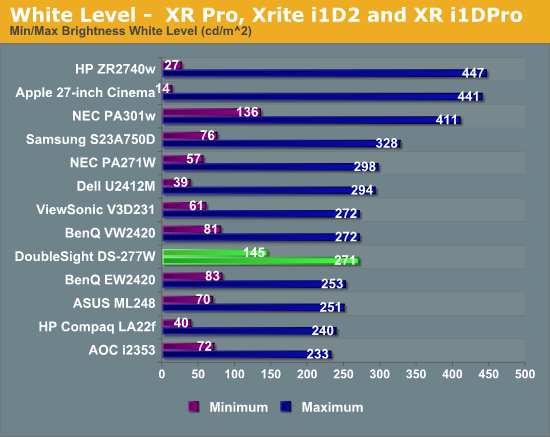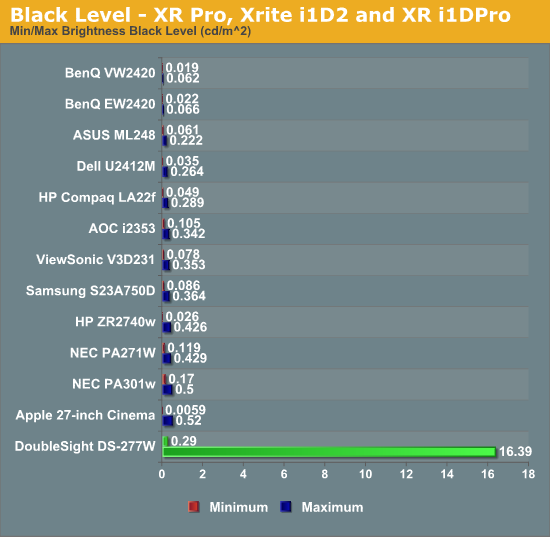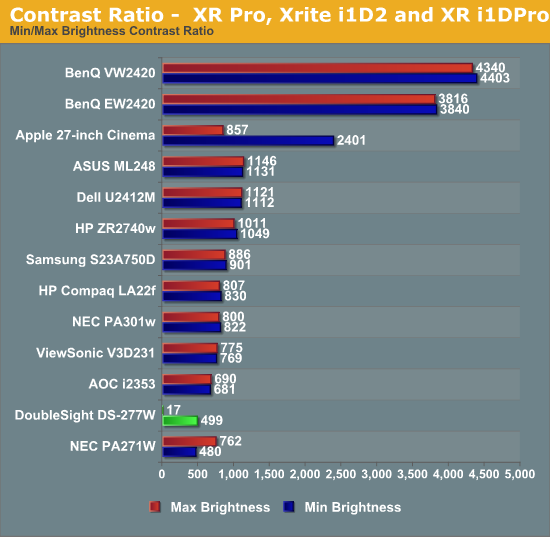DoubleSight DS-277W: Back to the Drawing Board
by Chris Heinonen on June 13, 2012 1:30 AM ESTMost of the 27” monitors that have come through have been able to get incredibly bright, as the backlighting systems need to be pretty powerful to light up a 27” panel well and keep uniformity. Here the DoubleSight comes in closer to the NEC PA271W than to the other 27” or 30” monitors we have tested and can only put out 271 nits at maximum brightness. With the brightness set to minimum we only get down to 145 nits, which is much brighter than anything else we have tested, and it means that our 100 nits dE testing required lowering the output level by adjusting the LUTs in the video card, which can cause posterization and other issues.

The black level at the minimum backlight is 0.29 nits, which is pretty reasonable. I also engaged the dynamic backlighting system and that dropped the level on a black screen down to 0.189 nits, which improves the contrast ratio quite a bit. Unfortunately, you can clearly see the dynamic backlight in use, and the screen fluctuates in brightness very clearly, which I found to be very annoying in use. The main issue is looking at the black level at maximum brightness, as it is over 16 nits! That’s over 32 times as bright as the closest display and really out of the ordinary, so what is going on?

The answer lies in how TV and Monitor controls work. On a TV, brightness controls the level of black, and contrast controls the level of white, and on a flat panel TV there is typically a backlight or cell light control to adjust the light output. On a monitor, there is no backlight or cell light control; brightness handles that. Since computer displays use the full 0-255 RGB gamut, unlike video that uses 16-235, there is no need for a black level adjustment. On the DoubleSight, the electronics are designed to work like on a TV, so instead of adjusting the light output, we are adjusting the black level. Similarly Contrast serves the purpose now of controlling white and the maximum light output. Basically, for use as a computer display, these controls are not designed correctly.
Given that black level, we would expect to see the contrast ratio at maximum light output be pretty poor, and it clocks in at 13:1. At minimum it was a respectable 499:1 and even at 200 nits I measured around 400:1, but once the brightness gets too high, your contrast ratio goes away.

Suffice it to say, the DS-277W was not a good performer on the brightness and contrast testing here. Hopefully that doesn’t carry over to every aspect of the display.










55 Comments
View All Comments
semo - Wednesday, June 13, 2012 - link
You guys need to concentrate a lot more on monitors that have DP. There must be plenty of budget displays out there with DP so why do you keep choosing the ones without!SteveTheWalrus - Wednesday, June 13, 2012 - link
this one was supposed to, but didn't...and why should they focus on DP anyways, at least for now its not very common.
mczak - Wednesday, June 13, 2012 - link
This monitor has 4 inputs, but only one is really useful for driving it at native resolution (it may or may not work over the VGA inputs but clearly you don't want to do that, and while 2560x1440 is doable over hdmi with newer hdmi standard I've yet to see a monitor which can actually do it, not to mention on the graphic card side almost noone can do it neither). Plus DL-DVI gets out of fashion too - new amd graphic cards only have one such port, not to mention for instance intel igps whose dvi outputs are never dual-link and can drive such resolutions only over DP. So for a monitor of this class the input options are not really useful.Not that it matters, the broken brightness handling (inability to control backlight, which both leads to bad picture and higher than necessary power draw) completely disqualifies this device to be taken seriously anyway.
cheinonen - Wednesday, June 13, 2012 - link
Right, while the HDMI 1.4 standard allows for higher resolutions, the main issue is that lots of the transmitter chips don't have support for that resolution in them, so most vendors are then stuck designing their own chip (expensive) or sticking to lower resolutions over HDMI. Now that ATI and NVIDIA are supporting it, I'm guessing we will see support for it over HDMI in the future.Menty - Wednesday, June 13, 2012 - link
I've yet to meet a single person who uses DP for connecting their machine to their monitor - and that includes Mac users. Most of them use mini-DP to HDMI/DVI converters. DP is just a fad, no doubt once Apple comes up with the next "best interface ever", it'll disappear like all the others.Fleeb - Wednesday, June 13, 2012 - link
How is DP a fad?"...doubt once Apple comes up with the next "best interface ever"..."
You mean like Firewire?
Kaldor - Wednesday, June 13, 2012 - link
I had to laugh when you said this.I have a buddy who is a PC user but is going to school for graphics design, video and such. The instructors swear up and down that he needs a Firewire external HD because the all macs have Firewire ports. His home PC does as well, but as I explained to him, he would be screwed if he needed to hook up to any other PC that doesnt have Firewire. I strongly urged him to buy a USB3 enclosure, and tell the instructors to pull their heads outta their ......
mtekr - Wednesday, June 13, 2012 - link
... and now all the portables, minus the 17" MBP, have USB3.futurepastnow - Wednesday, June 13, 2012 - link
And the "Retina" Macbook Pro doesn't have a Firewire port at all.Bownce - Thursday, June 14, 2012 - link
THUNDERBOLT!